Due to its simplicity, Chinese steamed egg is a Cantonese home-cooked dish that might not be featured on some Chinese restaurant menus. However, this ultimate steamed egg recipe has a burst of flavor you will never anticipate.
My mother frequently prepared steamed eggs for my family during my teenage years. However, since I left my hometown to work in Kuala Lumpur, I have not had this home-cooked dish for many years.
Note: This post may contain affiliate links. Please read my privacy policy for more info. I may receive commissions for purchases made through links in this post. As an Amazon Associate, I earn from qualifying purchases.
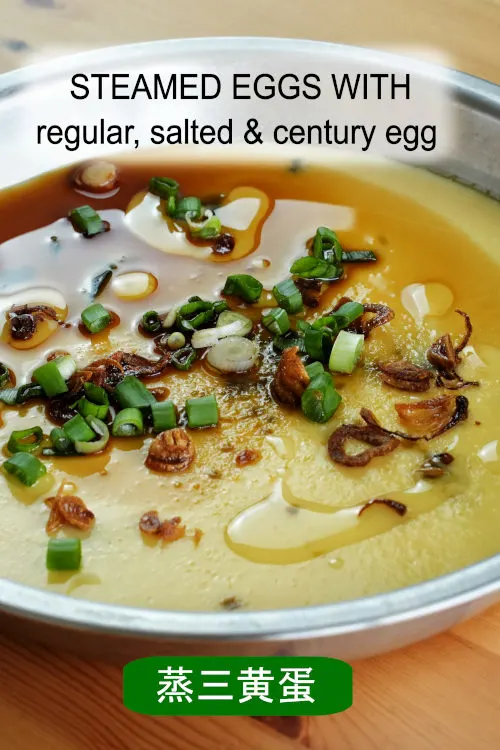
1. Why is this steamed egg recipe so flavorful?
This steamed egg recipe is an intricate blend of three egg varieties: the familiar chicken egg, the distinct century egg, and the flavorful salted egg. This triumvirate of eggs weaves a tapestry of flavors that captures the heart of every Cantonese I know.
This steamed egg dish is a combination of three types of eggs:
- Century eggs, also known as thousand years eggs, are made with a unique preservation process that transforms their texture and color, rendering them unique, especially considered an exotic flavor for non-Asians. The century egg is known for its earthy, salty, creamy, and pungent taste, often likened to blue cheese with a subtle hint of ammonia. While some people find it addictive, others may find it unpleasant due to its strong aroma.
- Salted eggs, on the other hand, are prepared by soaking them in a brine solution, infusing them with a distinctive salty flavor.
- The last one is the humble regular chicken eggs.
2. Crafting the Perfect Triple Steamed Egg
The preparation is simple. First, the chicken eggs are gently beaten with cold water, mirroring the same process of preparing Chinese zheng shui dan (蒸水蛋, steamed egg with water). However, what sets this variation apart is the addition of salted and century eggs. The strong savory flavor of these eggs obviates the need for additional seasoning with salt and ground white pepper, chicken stock, or anchovy broth.
The preparation continues with removing the eggshell of the salted eggs. The egg whites are segregated from the yolks, then combined with the beaten eggs. The yolks, which are semi-solidified, are cut into small pieces, then added to the egg mixture.
During my stay in New Zealand, I discovered that raw salted eggs were not readily available in Auckland’s Asian grocery stores. As a suitable alternative, pre-cooked salted eggs were sold. Nevertheless, I cut the cooked salted egg whites and yolks into smaller pieces. Although the resulting texture differs from the raw, briny egg whites, the outcome remained surprisingly impressive.
Lastly, the century egg is a true enigma to most non-Asians, due to its grayish-green, translucent white with a jelly-like consistency. The flavor profile, too, diverges from the original egg, which becomes an acquired taste for many non-Asians.
Preparing the century eggs involves a similar process as the salted eggs, that’s to cut them into small pieces.
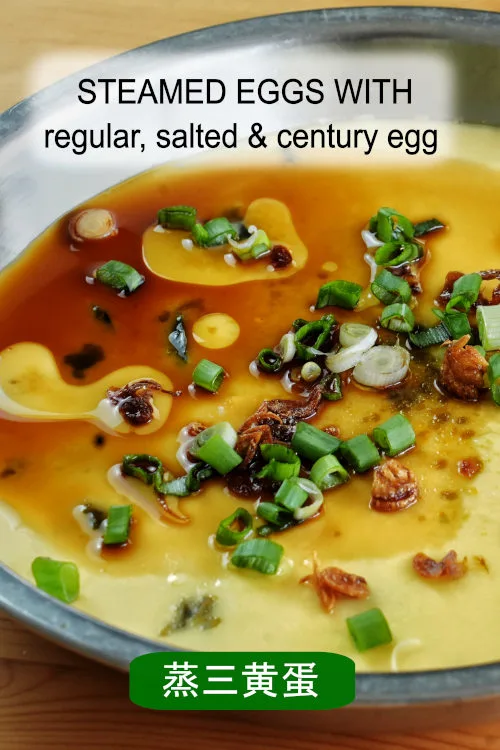
3. Steam the eggs to perfection
Once you have combined all the eggs, pour them into a shallow plate with raised edges. The shallow plate is preferred as it ensures even cooking, allowing the mixture’s surface and inner depths to cook simultaneously, a crucial step in achieving the velvety custard consistency.
I utilize a stainless steel wok furnished with a snug-fitting lid and a trivet that supports the plate. An electric steamer with a steamer basket would be an ideal investment for those engaged in frequent home steaming cooking.
I prefer the stainless steel plate due to its superior heat conductivity. However, choosing a ceramic bowl for enhanced presentation or any other heatproof bowl is entirely up to you.
When the water boils, place the place of steamed eggs on the trivet and steam over low heat.
Typically, the steaming time is about eight to ten minutes to cook until the steamed egg custard achieves a slightly jiggly and silky texture. The simple trick is to steam over low heat.
After removing it from the steamer, drizzle a combination of oyster sauce, light soy sauce, and shallot oil (or sesame oil) to enhance the flavor. You may opt for fish sauce for a change, although that is not common for Cantonese. Garnish with finely sliced spring onions (green onions). It is a great dish to serve with steamed rice.
Note: Please refer to this recipe to prepare the shallot oil and crispy shallot.
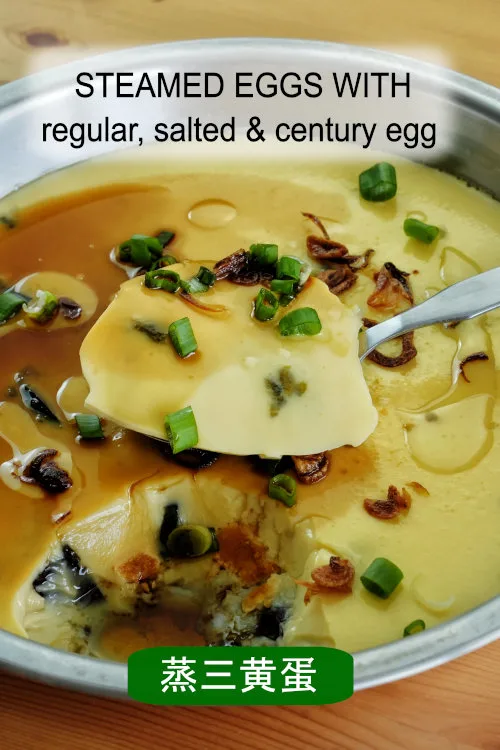
4. Exploring Variations of Chinese Steamed Eggs
If you like this recipe, you’ll relish trying other egg dishes.
For example, the classic Cantonese-style Chinese steamed egg is prepared by omitting the salted egg and century egg. This rendition boasts a luxuriously smooth texture. The technique involves incorporating cold water into the beaten egg mixture and covering it with cling film or plastic wrap, guarding against water droplets that could mar the custard’s impeccably even surface. Then, steam the mixture until the custard achieves a velvety consistency. This dish is a beloved comfort food among Cantonese households, particularly cherished by the older generation. For more detailed instructions, please refer to this article.
Another rendition of steamed eggs involves combining salted eggs with ground meat. Given the denser nature of meat, a slightly prolonged steaming time is warranted to ensure thorough cooking.
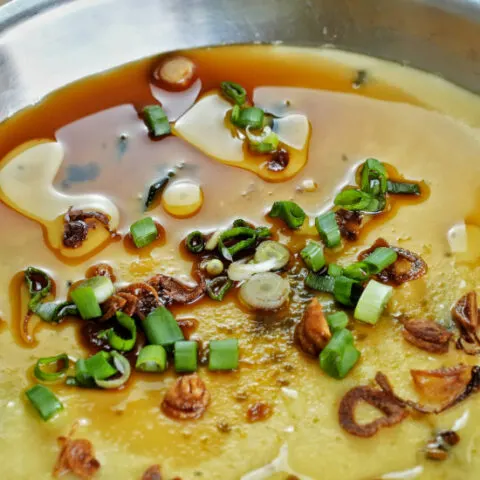
Steamed egg recipe - with salted egg, century egg, and regular egg
A beloved Cantonese recipe combines salted, century, and regular eggs, resulting in rich flavor and perfect comfort food.
Ingredients
Ingredients A
- 3 regular eggs
- 1 century egg
- 1 salted egg
- 225ml water
Ingredients B
- 1 tsp light soy sauce
- 1 tsp oyster sauce
- 2 tsp shallot oil
- 1 tbsp spring onions (thinly sliced)
Instructions
- Crack the regular eggs into a large mixing bowl.
- Crack and remove the shell of the salted egg. Separate the egg yolks and whites. Add the salted egg whites to the mixing bowl and beat until homogenous,
- Cut the salted egg yolks into small pieces.
- Crack and remove the shell of the century egg. Cut it into small pieces, just like the salted egg yolk.
- Combine the salted egg yolks and century egg with the beaten eggs.
- Pour the eggs into a shallow plate with raised edges.
- Set up a steamer, and when the water is boiled, steam the egg over low heat until cooked. (around 8-10 minutes)
- Remove from heat, then drizzle the light soy sauce, oyster sauce, and shallot oil on top.
- Garnish with thinly sliced spring onions to serve.
Recommended Products
As an Amazon Associate and member of other affiliate programs, I earn from qualifying purchases.
Nutrition Information:
Yield: 3 Serving Size: 1Amount Per Serving: Calories: 184Total Fat: 14gSaturated Fat: 3gTrans Fat: 0gUnsaturated Fat: 10gCholesterol: 454mgSodium: 450mgCarbohydrates: 2gFiber: 0gSugar: 1gProtein: 12g
This data was provided and calculated by Nutritionix on 8/20/2023

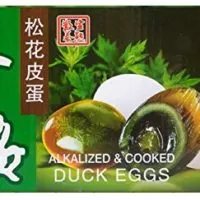
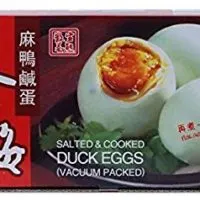
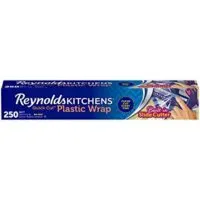

HillSeah
Friday 8th of September 2023
Nice
Queenie
Tuesday 22nd of August 2023
Thank you. I enjoy all your recipes and follow you. Because my mistake was I did not write down all the recipes that my mum was cooking while she was with us. Please give me your recipe for Kaya egg n coconut jam. Thank you
KP Kwan
Sunday 20th of August 2023
Hi, this is KP Kwan. I am happy to see you in this comment area, as you have read through my recipe. I am glad to reply to any questions and comments as soon as possible.